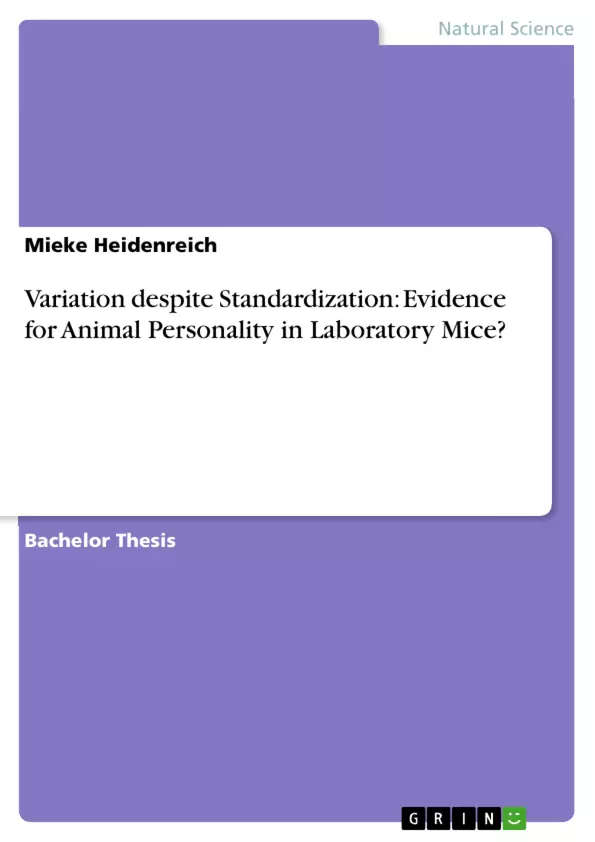It is generally assumed that human beings have personalities, while animals do not. This assumption is not only derived from common sense, but also a basic principle of western philosophy and social theory (Mead, 1934). Still, dog owners will not stop mumbling about their cute puppy's unique personality. And they find support from unexpected source: Biologists argue that humans are nothing more, nothing less than animals. So they, too, begin to take into consideration that animals – including humans – might have a personality. What seems like a solely philosophical question at first glance, has important practical impacts, because the existence of animal personality contradicts the assumption that animals used in biological experiments can be standardized, and have uniform properties. If despite all efforts of standardization a residual variation cannot be eliminated, pharmaceutical and medical experiments might lose part of their validity.
Therefore the hypothesis that laboratory mice possess a personality was tested in an empirical study. In this study a set of standard behavior tests was performed with 40 female mice of the strain C57BL/6N. The data was then analyzed for correlations over time and across contexts, since this is a requirement for animal personality.
Inhaltsverzeichnis (Table of Contents)
- Introduction
- Definition
- State of the Art
- Standardization
- Hypotheses
- Animals, Material, and Methods
- Animals, housing, and experimental conditions
- Behavioral tests
- Experimental Design
- The Elevated Plus Maze (EPM)
- The Open Field Test (OF)
- The Object Exploration Test (OBX)
- The Social Investigation Test (SI)
- The Dark/Light Test (DL)
- The Free Exploration Task (FET)
- Videos and computer software
- VirtualDub
- Optimas
- Tracking Analysis
- Statistical analysis
- Results
- Correlations over time
- The Elevated Plus Maze (EPM)
- The Open Field Test (OF)
- The Object Exploration Test (OBX)
- The Social Investigation Test (SI)
- The Dark/Light Test (DL)
- The Free Exploration Task (FET)
- Correlation across contexts
- The Elevated Plus Maze (EPM)
- The Open Field Test (OF)
- The Object Exploration Test (OBX)
- The Social Investigation Test (SI)
- The Dark/Light Test (DL)
- The Free Exploration Task (FET)
- Differences between individuals
- Correlations over time
- Discussion
- Correlation over time
- Correlation across contexts
- Differences between individuals
- Implications
Zielsetzung und Themenschwerpunkte (Objectives and Key Themes)
The main objective of this study is to empirically test the hypothesis that laboratory mice possess a personality. The study aims to understand if individual mice demonstrate consistent behavior across different situations and time periods. The study employs a set of standard behavioral tests to investigate potential personality traits in a group of female C57BL/6N mice.- The study investigates the concept of animal personality, exploring the consistency of behavior across time and context.
- The research aims to determine if laboratory mice demonstrate individual differences in behavior, despite standardized conditions.
- The study explores the implications of the presence of animal personality for biomedical research, animal welfare, and the understanding of animal behavior.
- The study analyzes data from various behavioral tests to identify correlations over time and across different contexts, providing evidence for potential personality traits in mice.
- The research examines the impact of standardization on the consistency of individual differences in behavior, raising questions about the validity of assuming standardized animal behavior in experiments.
Zusammenfassung der Kapitel (Chapter Summaries)
Introduction:
This chapter introduces the study’s aim of examining the possibility of animal personality in laboratory mice, a concept often challenged by the assumption of standardization in animal research. The chapter defines animal personality, highlighting the concept of intra-individual behavioral consistency across different environmental challenges and time periods. The chapter also provides an overview of existing literature on animal personalities, focusing on studies that highlight behavioral consistency across situations, temporal consistency, and inter-individual variability. The chapter then addresses the issue of standardization in animal research, highlighting recent studies that question the complete elimination of variability in animal experiments. Finally, the chapter outlines the three hypotheses that will be tested in the study: individual behavior is correlated over time, individual behavior is correlated across contexts, and individuals show differences in behavior.Animals, Material, and Methods:
This chapter details the materials and methods employed in the study. It describes the animals, their housing conditions, and the experimental setup. The chapter then provides a detailed explanation of the six behavioral tests used to assess anxiety-like, exploratory, and social behavior in the mice: the Elevated Plus Maze (EPM), the Open Field Test (OF), the Object Exploration Test (OBX), the Social Investigation Test (SI), the Dark/Light Test (DL), and the Free Exploration Task (FET). Each test is described in detail, outlining the testing procedure, the parameters measured, and the theoretical basis for its application in the study.Results:
This chapter presents the findings of the study, focusing on the correlations over time and across different contexts. The results are presented in detail, highlighting the significant correlations observed in various parameters and the lack of correlation in others. The chapter discusses the specific parameters measured in each test, providing a comprehensive overview of the data analysis.Schlüsselwörter (Keywords)
The study focuses on the exploration of animal personality in standardized laboratory mice, examining the consistency of behavior over time and across different contexts. Key areas of investigation include: animal personality, behavioral consistency, inter-individual differences, standardization, behavioral tests, and biomedical research.- Quote paper
- Mieke Heidenreich (Author), 2011, Variation despite Standardization: Evidence for Animal Personality in Laboratory Mice?, Munich, GRIN Verlag, https://www.grin.com/document/201322



